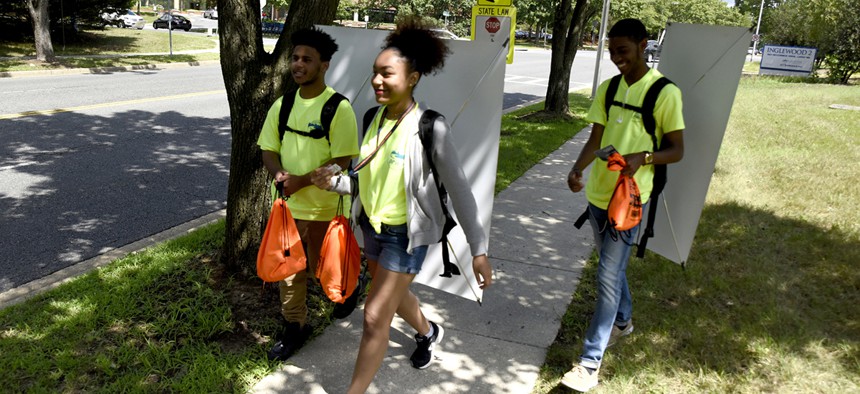Engaging Teens With More Than Just a Summer Job

Job options include local government agencies, faith-based and nonprofit organizations and private businesses. Prince George's County

Connecting state and local government leaders
The Summer Youth Enrichment Program in Prince George's County, Maryland, aims to help teenagers long-term.
A summer employment program in Prince George’s County, Maryland, has helped nearly 15,000 teenagers secure seasonal jobs with government agencies, nonprofits and private businesses in the past five years.
But the goal of the six-week program, officials said, is not simply to provide teenagers with seasonal work. Instead, county leaders hope teenagers' time in the Summer Youth Enrichment Program will show them potential career paths, increase engagement with education and set them on a path to long-term success.
“They learn how to keep a job. They learn what life skills they need,” said Prince George’s County Executive Rushern L. Baker III, who started the current program. “It also translates into them then understanding why it’s so important to get that high-school diploma.”
Along with working a summer gig, teens in the program can also participate in community-building opportunities in impoverished neighborhoods and attend training sessions that focus on life and job skills and specific career paths.
The county had a jobs program when Baker took office in 2010, but it was mostly focused on simply helping teenagers—about 300 each year—find summer jobs within local government. Baker began tweaking the initiative after the 2012-2013 school year, when seven teenagers across the county were killed during a general spike in the area’s homicide rate.
“These happened during the summer, when these children were not engaged in any summer job. There was a big cry to do more,” he said. “What I wanted was not just for us to come up with a summer job program. I wanted them to have skills that could carry them through college and into a career.”
The county began by partnering with Prince George’s Community College and the public school system to offer a job readiness training curriculum for teenagers accepted into the summer program. The training, held over a six-week period, teaches job skills like good attendance and appropriate attire, along with workplace conduct and basic financial literacy. It’s voluntary, but teens who complete it get priority on their job placements.
County officials also added a voluntary orientation session to discuss goals and expectations for the summer program, along with an in-service training at the community college that focuses on “communication skills and other essential skills that often challenge today’s youth.” The county began partnering with private-sector businesses and nonprofits to increase placement options for program applicants, allowing enrollment to grow each year. Current options for participants still include county government jobs (the Board of Elections, the Department of Corrections, the State’s Attorney’s Office), along with nonprofit and faith-based organizations (Accokeek Foundation, ECO City Farms, Maryland Community Connection) and private corporations (Six Flags, Pepco, Kaiser Permanente).
“The previous summer youth program would place kids within county departments, but it had no training component and at that time was placing maybe 200 to 300 kids per summer,” said Stephanye Maxwell, director of the county’s office of human resources management, which administers and oversees the summer program. “And we would get over 4,000 applications. There was a real need in the community—it was a clarion call. And the county couldn’t do it alone. We needed to make it a collaboration.”
Students also have the opportunity to work as part of the county’s Transforming Neighborhoods Initiative, a program that focuses on revitalizing six neighborhoods with economic, public safety and health problems. The summer enrichment program recruits students from those areas and allows participants to work on projects in affected neighborhoods, finding real-world solutions for concrete problems.
“We target our program in some of our highest-need areas, so we made sure that opportunities were offered there,” Baker said. “We want the young people to be doing something of substance, so we started giving them directions on these problems we were trying to solve as a government.”
At the conclusion of the program, many job sites host a finale for participants, allowing teenagers to show what they’ve learned or debut a project they’ve worked on. Last year, 11 students who were placed at the Accokeek Foundation’s Agriculture Conservation Corps designed and installed floating wetlands in a pond at Piscataway Park. Another participant developed a database to help the city of Hyattsville digitize and archive records and documents.
Thus far, the county has not tracked program participants long-term or collected quantifiable data on their experiences, though that’s in the works for next year, Matthews said. Rates of crime and truancy have dropped since the program expanded, likely due to a host of factors beyond just summer enrichment, Baker said. But community engagement has endured, as has enthusiasm among program applicants and participants as well as job-placement partners.
“I think one of the reasons is that the buy-in started at the top, with the county executive,” Matthews said. “He convened a meeting with the president of the community college, the superintendent, the state’s attorney—just all of the high-end people in all of these places—and articulated the need for something that was going to assist our young people. Everyone is behind this because they see the returns and what it means to the community and to the youth.”
Kate Elizabeth Queram is a Staff Correspondent for Government Executive’s Route Fifty and is based in Washington, D.C.

NEXT STORY: Despite Economy, Working Families Struggle to Make Ends Meet




